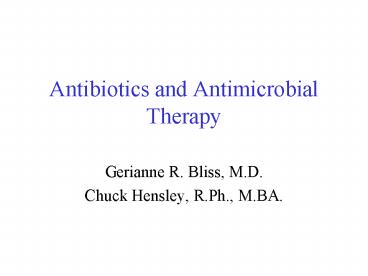Antibiotics and Antimicrobial Therapy PowerPoint PPT Presentation
1 / 31
Title: Antibiotics and Antimicrobial Therapy
1
Antibiotics and Antimicrobial Therapy
- Gerianne R. Bliss, M.D.
- Chuck Hensley, R.Ph., M.BA.
2
Basics of Therapy
- Classification and selection
- Based on the principle of selective toxicity
3
Which type of organism
- Antibacterial
- Antifungal
- Antiviral
- Antiparasitic
4
Site and Mechanism of Action
Inhibitors of
- Cell wall synthesis
- Protein synthesis
- Metabolic/protein synthesis
- Cell membrane synthesis
5
Antimicrobial Activity
- -cidal versus -static
6
Spectrum
- Narrow
- Extended
- Broad
7
Sensitivity and Resistance
- MIC minimum inhibitory conc
- CDKR conc dependent killing rate
- PAE postantibiotic effect
8
Sensitivity and Resistance
- Susceptibility
- Intermediate sensitivity
- Resistance patterns
- Mutation and selection
- Transferable resistance
9
Resistance- Mechanisms
- Inactivation
- Decreased accumulation
- Reduced affinity
10
Selection of Antimicrobial Drugs
- HOST FACTORS
- Allergies
- Age
- Immune Status
- Renal Impairment
- Hepatic Insufficiency
- Abscesses
- Indwelling Catheters
11
Drug Characteristics
- Antimicrobial Activity
- Pharmacokinetic Principles
- Adverse Effect Profile
- Cost and Convenience
12
Combination Drug Therapy
Relationship/effect may be
- Antagonistic
- Additive
- Synergistic
- Indifferent
13
Prevention
- Invasive procedures
- Prevent disease transmission
Refer to The Sanford Guide to Antimicrobial
Therapy 2002
14
Antibacterial Classification
- Inhibitors of Cell Wall Synthesis
- Inhibitors of Bacterial Protein Synthesis
15
Inhibitors of Cell Wall Synthesis
Inhibition of cell wall synthesis is bactericidal
- Gram positive negative have cytoplasmic
membrane and cell wall - Gram negative has outer membrane with porins
16
Site of Drug Action
- Beta-lactam drugs bind to penicillin-binding
proteins and disrupt functions of the cell wall
- Other inhibitors block synthesis of the cell wall
17
Beta-Lactam Antibiotics
- Includes following
- penicillins
- beta-lactamase inhibitors
- cephalosporins
- monobactams
- carbapenems
18
Penicillins
- Narrow Spectrum
- Penicillinase Resistant
- Extended Spectrum
- Beta-Lactamase Inhibitors
19
Drug Properties
- Synthetic vs. semi synthetic
- Acid stable vs. acid labile
- Spectrum and indications
- Hypersensitivity reactions
20
Beta-Lactamase Inhibitors
- Beta-lactamases inactivate beta-lactam antibiotic
- Suicide inhibitors surrogate substitute
- Clavulanate, sulbactam, tazabactam
- Given with beta-lactam antibiotic to prevent
degradation by bacteria
21
Cephalosporins
- Four generations
- Greater resistance to beta-lactamases
- Wider range of antimicrobial activity
- Little toxicity to host
- Some cross-reactivity with penicillins
- Can cause platelet dysfunction
22
Monobactams
- Aztreonam
- For gram negative organisms
- IV only
- Bone marrow suspression
23
Carbapenems
- Wide range of bacteria both gram and
- Can cause hematologic reactions
24
Other Cell Wall Inhibitors
- Vancomycin
- Bacitracin
- Cycloserine
- Fosfomycin
25
Inhibitors of Bacterial Protein Synthesis
- Selective blocking of protein synthesis at the
ribosome - Bacteriostatic
26
30s Ribosomal Subunit Antibiotics
- Aminoglycosides
- Given parenterally
- Not metabolized
- Renal excretion
- Peak and trough levels to avoid toxicity
- Gram neg spectrum
- Nephrotoxicity and ototoxicity
27
Tetracyclines
- Broad-spectrum
- Widespread resistance-R factors
- Avoid in pregnant women and children less than 8
years - Renal, liver, and skin toxicity
- Bind calcium, aluminum and iron
28
Spectinomycin
- Can be use to treat gonorrhea
- Causes nausea and pain at site of injection
29
50s Ribosomal Subunit Antibiotics
- Macrolides
- Erythromycin and semi-synthetic derivatives
- Upper and lower respiratory tract infections
- Remember
- GI upset
- Cholestatic jaundice
30
Other 50s ribosomal antibiotics
- Clindamycin
- Good for gram pos cocci
- Increased incidence of pseudomembranous colitis
- Chloramphenicol
- - anemia
- Quinupristin-Dalfopristin
- - streptogramin-new class
31
Mupirocin
- Structurally unrelated to all other antibiotics
- Inhibits protein synthesis through unique
mechanism - No cross-resistance
- Topically active against Staph and Strep

